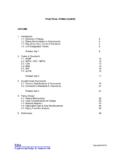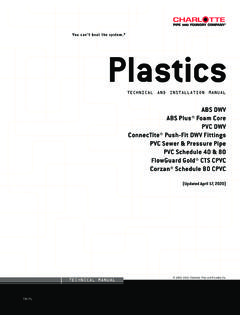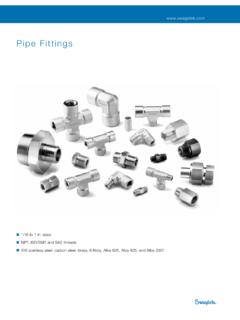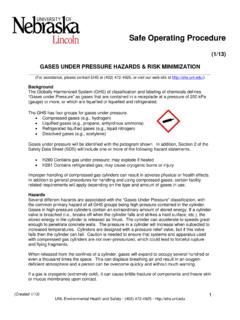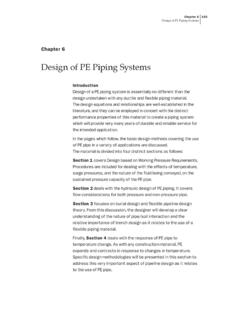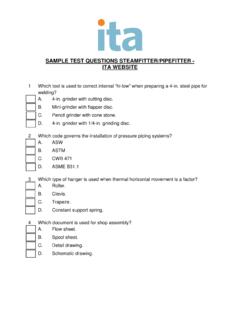Transcription of Polyethylene Water Service - plastic pipe
1 Polyethylene Water ServicePipe and Tube Installation Guide2 The plastic pipe and Fittings AssociationSCOPEThis guide presents recommendations for the installa-tion of Polyethylene (PE) piping intended for undergroundwater supply for residential, rural and light keeping with generally accepted practices and therecommendations included in applicable standards of theAmerican Water Works Association (AWWA), only PE pipeand tubing of not less than a 160 psi pressure rating forwater at F should be used for Water Service guide recommends that PE Water Service pipes only beinstalled underground, except for any necessary lengthabove ground for making appropriate connections to otherapproved above ground Water distribution statements and descriptions in this guide areinformational only.
2 They are not intended as anendorsement or warranty with respect to any product,component or system. The plastic pipe and FittingsAssociation (PPFA) and its members make no warran-ties or representations, expressed or implied, as to: thefitness of any product or system for any particularpurpose; the suitability of any product or system forany specific application; or the performance of anyproduct or system under actual Service all cases, use of materials, details of installation,and methods of construction should be in accordancewith the requirements of all applicable local codes andproject specifications. In addition, the manufacturer sinstallation and product application recommendationsshould be followed. Applicable code requirements orregulations, project specifications and manufacturer srecommendations take precedence over any recommen-dations contained in this manual in the event there manual does not purport to address all of thesafety concerns that may be associated with the use andinstallation of PE piping.
3 It is the responsibility of theuser and installer to use and install PE piping, and touse any necessary equipment, materials and tools, inaccordance with appropriate safety and health practicesand all regulatory and Qualification for Potable WaterService. Most federal, state and other health authoritiesin the United States recognize the requirements formaterials intended for the conveyance of potable waterwhich have been established by NSF Internationalunder their ANSI/NSF Standard 14 (See NationalStandards). In Canada, the requirements are those ofthe Canadian Standards Association (CSA), and theseare equivalent to those of NSF. PE pipe intended forpotable Water Service is only made from NSF or CSAapproved formulations. Such approval is generallysignified by inclusion in the pipe markings of eitherthe NSF or the CSA seal of approval (See ProductIdentification).
4 Installation in Soils Contaminated by materials, in common with other plastics andelastomers and porous materials such as concrete andasbestos cement, may be subject to permeation bycertain solvents and petroleum products. When pipe isto be installed in soils which may contain organicpollutants such as solvents, heating oil, gasoline orother petroleum products, or their vapors, the manufac-turer of the pipe or the piping component should beconsulted prior to material selection regarding the riskof permeation. PE piping should not be installed insoils that contain, or are likely to contain, significantquantities of organic NOTICE3 Polyethylene Water Service pipe and Tube Installation GuideContentsScope2 Important Notice2 Before Proceeding with Installation of a PEWater Service Line5 Background Information on PE Piping6 National Standards Under Which PE WaterService Piping Is Made7 Product Identification8Do s and Don ts on Handling8 Installation8 Check List for Proper pipe Installation11 Joining Methods & Fittings12 Check List: Making Joints with PE Pipe13 pressure Testing13 Disinfection13 Appendix14 Dimension Ratio14 Table 3: PE Water Service pipe pressure Ratingversus Product SDR or SIDR15 Table 4: pressure ratings (PR) forElevated Temperatures15 Table 5.
5 pipe Made to Standard OutsideDiameters16 Table 6: Tubing Made to StandardOutside Diameters16 Table 7: pipe Made to Standard InsideDiameters16 Table 8: Iron pipe Size per ASTM D 3035 SDR 11 pipe 160 psi Maximum Operating Pressure17 Table 9: Iron pipe Size per ASTM D 3035 SDR 9 pipe 200 psi Maximum Operating Pressure18 Table 10: copper Tube Sized per ASTM D 2737 SDR 11 pipe 160 psi Maximum Operating Pressure19 Table 11: copper Tube Sized per ASTM D 2737 SDR 9 pipe 200 psi Maximum Operating Pressure20 Table 12: Iron pipe Sized per ASTM D 2239 SIDR 9 160 psi Maximum Operating Pressure21 Table 13: Iron pipe Sized per ASTM D 2239 SIDR 7 pipe 200 psi Maximum Operating Pressure224 Polyethylene Water Service pipe and Tube Installation GuideBefore proceeding with the installation of a PE waterservice line, the installer should become familiar with theentire contents of this guide.
6 Information included indifferent sections is often interrelated in its to handling, working with, and installing PEwater Service pipe , the installer should become aware ofthe performance properties of PE piping which need to beconsidered and addressed to ensure a successful, durableapplication (See Background Information).Also, prior to starting a job the installer shouldconfirm that: The pipe and fittings to be installed comply withthe requirements of the project, and with any applicablecode requirements. For this purpose, pipe and fittingsmarkings should be carefully checked (See ProductIdentification). The pipe markings do include a section notingthat the pipe is suitable for potable Water Service . The fittings have been designed and sized to becompatible with the pipe dimensions (See PE PipeDimensioning Systems, and Joining Methods & Fittingsand Appendix: pipe & Tube Dimension Ratio.)
7 The pipe and fitting manufacturer s installationrecommendations have been consulted and all those thatare supplementary to these general recommendationshave been noted. The maximum anticipated working and surgepressures and maximum anticipated operating tempera-tures are within the rated capacity of the pipe and fittings(See discussion in Appendix: pipe & Tube PressureRating, pressure Class & Surge pressure Tolerance). The proposed routing of the Service line whilelargely dictated by expediency and economy results ina minimum number of sharp changes in direction, with nobend having a smaller bending radius than recommended(See Installation: Bends in Service pipe ). The necessary equipment, tools and materials areavailable for achieving firm and stable support of thepipe at those points where it connects to rigid structuresand a protection sleeve is available for placement overthe tap connection at the main (See Installation: Extrane-ous Loads).
8 BEFORE PROCEEDING WITHINSTALLATION OF A PE WATERSERVICE LINEPE Water plastic pipe and Fittings AssociationPolyethylene (PE) pipewas first commercially madein the 1940s, after World WarII. Today, it is the secondmost widely used plastic pipematerial, after polyvinylchloride (PVC). These twomaterials account for over 90percent of all currentlyproduced plastic is a non-conductor and therefore not susceptibleto galvanic or electrochemical corrosion, the mechanismthat limits the durability of buried metallic pipes. It isalso unaffected by most acids, alkalis, and corrosive excellent toughness and flexibility distinguish is very resistant to damage by impact, even at lowertemperatures. It is a ductile material that does not shattereven if punctured or cut regardless of Service withstands the effects of cyclic or repeated stressing(such as by Water pressure surging).
9 Its greater flexibilitypermits the coiling of smaller diameter pipes, whichreduces fitting requirements and facilitates pipe s toughness allows it to resist failure under theexpansive action of freezing protect PE pipe during extended outdoor storageagainst the effects of the sun s ultraviolet (UV) radiation which over time can damage most plastics PE pipecompositions include additives that either physicallyscreen or chemically absorb UV rays. The commonly usedUV screen is finely divided carbon black, hence the blackcolor of many PE pipes. Black PE pipe has excellentweathering resistance. pipe made to other colors relies onstabilizers to absorb UV rays. Since these UV stabilizersare somewhat less effective than carbon black, non-blackpipe should not be stored outdoors for extended periods( , not longer than a few months) unless it is shieldedagainst direct sunlight, as by the use of a tarp.
10 Of course,once installed underground or away from sunlight, UVprotection is no longer PE pipe has sufficient strength, toughness, andchemical resistance for Water Service pressure piping incommon with other plastics, it has certain limitations onits performance just as any other engineering limitations include the following, which must berecognized and addressed to ensure a proper and durableinstallation: Mechanical properties are temperaturesensitive. As temperature increases, PE becomes lessstrong and less stiff. For continuous use where the pipetemperature exceeds 80 F, the pipe pressure ratingshould be appropriately reduced (See Appendix: Tem-perature Compensation). The coefficient of thermal expansion/contrac-tion is higher than metal. For the same change intemperature, unconstrained PE pipe expands about 8times as much as metallic pipe .
